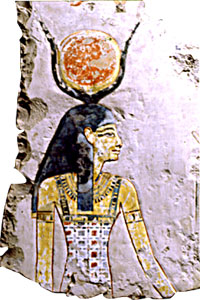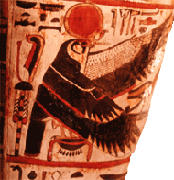Ancient
Egyptian Animals
| |
Egyptology Articles
Herbs and Aroma
Alternative
Medicine
Aroma Therapy
|
The ancient Egyptians
were very fond of animals. They had animals that were sacred, some were
pets and other were used in farming. Animals were thought to be sacred to
the Egyptians because they believed that when one of their gods or
goddesses came down to earth, they would represent themselves as a
specific species. The Egyptians thought by honoring them, they would be
pleasing the god. They also thought that animals shared an afterlife with
their humans so it resulted in animals being buried within its family
tomb.
The animals that were considered especially sacred:
-
cat- The male cat had religious connections with Ra. Kittens were
specifically reared for sacrificial/worship uses .
-
cattle- Beef was often used as a sacrificial offering to various
deities.
-
scarab beetle- The emblem of a specific goddess, the scarab beetle was
associated with the daily birth of the sun, and credited with
spontaneous generation of its young. Because of its sacred status, it
was widely represented in art.
-
Jackel- it was considered a protector of royal tombs from robbers and
helped in the afterlife journey.
Cats
and Kittens:
One
of the most common animal mummies in Egypt was the cat. Cats were believed to
represent the goddess Bastet. Consequently, they were raised in and around
temples devoted to Bastet. When they died, they were mummified and buried in
huge cemeteries, often in large communal graves.
From about 332 B.C. to 30 B.C., animals began to be raised for the specific
purpose of being turned into mummies. The mummies were sold to people on their
way to worship a god and left at the temple as offerings. Scientists have
uncovered a gruesome fact: many cats died quite premature and unnatural deaths.
Two- to four-month-old kittens seemed to have been sacrificed in huge numbers.
So many cat mummies were made that researchers can only guess that there were
millions of them
|
 |
| |
Bastet |
Bastet:
Cats are very useful animals in a country that depends on grain. The cat's
hunting instincts were honoured by the Ancient Egyptians, but so was the cat's
gentler side as a warm and loving mother to her kittens. Bastet can be shown as
a woman with a feline head. There are disagreements among zoologists as to when
these animals first began to live with humans along the Nile, and about which
feline became the Egyptian pet. Cats do not appear as household pets during the
Age
of the Pyramids, though they were very popular animal companions in later
times.
Cattle
were thought to be sacred and beef was often used for offerings to the gods or
goddesses. A bull represented power, aggression, masculinity, fertility; these
could be the attributes of kingship. . The cow's large eyes with long lashes,
and her generally quiet demeanor suggested a gentle aspect of feminine beauty.
Her gift of milk, which could sustain a human child, became of symbol of love
and sustenance.
|
 |
|
Bastet |
Hathor:
|
Hathor
as the royal goddess. Her name means 'House of Horus." Her image
could take the form of a cow, a woman with a cow's head, or a woman
wearing the horns of a cow. As a motherly cow, she gave the king her
divine milk, and protected him as a cow protects her calf. She was the
goddess of love, music, singing, and dance. She was one of the most
important deities in the Age of the Pyramids, and her popularity
continued to the end of Egyptian civilization. In the early economy of
Egypt, cows were wealth. A herd of cattle was a beautiful sight because
it represented wealth in the form of food, milk, hides, and work, as
oxen pulled the ploughs of farmers. Cattle dung was a valuable
fertilizer and had many uses in building. The Egyptians admired many
qualities in cows, besides their economic benefits. The cow's careful
tending of her calf was a model for motherhood. In a time when many
women died in childbirth, the ability of cow's milk to sustain a human
baby was deeply appreciated. Cows, like
people, love music and will happily listen to a human singing, thus it
made sense for Hathor to be goddess of music. The big, gentle brown eyes
of cows set a standard for beauty. |
 |
|
Hathor |
The
Hawk
A
hawk, who soars high above the world of humans, seeming to expend no energy in
his long hours aloft, and who - far seeing, -can swoop in an instant to capture
his prey in sharp talons, became a symbol of kingship.
Anty:
Anty
was a hawk god of Upper Egypt. He is shown as a hawk sitting on a
crescent moon, or in a boat. He became associated with other hawk-gods,
such as Sokar
Horus:
|
This god is shown as a falcon, or as a man with the head of a falcon. In
Egyptian, his name is Her - the distant one. Like the good king who sees
everything in his kingdom, the hawk is noted for his sharp vision. The
sudden stoop of the hawk, as he leaves the distant sky to attack and
capture his prey, is like the quick and decisive action of a king in
defense of his country. Horus is one of the
oldest gods of the Egyptians. In the days when powerful leaders were
fighting to make one nation out of smaller settlements, the early rulers
were called Followers of Horus. On the Narmer palette, the King is shown
with a falcon whose one human arm holds a rope that passes through the
nose of a defeated rival. The earliest way of distinguishing the name of a
king from the names of others was the serekh, which was a rectangle
representing the palace of the king, with a hawk on the
top. |
 |
|
Horus |
Originally, there were at least
two gods called Horus. One is the fifth child of Nut and Geb, Horus the
Elder, and the other is the son of Isis and Osiris. Over time, their
stories and attributes came together. An old story tells of how Osiris,
king of Egypt, was murdered by his brother, Seth. Seth was very strong and
powerful. He took over the country, and ruled well. Isis, the wife of
Osiris, hid the child she had born, and raised him in secret.
When
Horus grew up, he claimed his father's throne. Seth and Horus struggled
for the kingship, but in the end Horus' claim, as son of the previous
king, was recognized by a court of all the gods, and Horus became king.
In Ancient Egypt, each king was Horus. When a king died, Egyptians said
that the falcon had flown to Heaven and united with the Sun Disk. The
next king then became Horus. Like the Hawk, the king was a fighter, a
warrior. This is why Horus, when shown as a hawk-headed man, wears an
armored breast-plate.
Anubis:
|
This jackal-headed god looked after the dead, and was in charge of the important
task of mummification. Anubis can appear as either a black canine with long
sharp ears, or as a man with a canine head. The black colour of Anubis is not
natural to jackals or to the wild dogs of Egypt; it may refer to the
discoloration of a body after death and during mummification. The black colour
also refers to the rich dark soil of Egypt, from which new growth came every
year; in similar manner, the dead would come to new life after burial. Dogs, as
animal companions, were present in Egypt from the very beginning. Sometimes dogs
were buried with their masters. It may have given the Egyptians comfort to think
of such an animal as guarding the cemeteries, protecting the dead.
|
 |
|
Anubis |
There
are other minor animals that were held sacred by the Egyptians so because they
were beneficial others because they were considered evil. Examples of these
animals are:-
The
mongoose was respected because of its skill and power of robbing nests and
eating snakes.
The
snakes were thought to be evil. Because the snake's poisonous bite, it killed
many people.
The
crocodile was known for its silent attacks on people near the Nile water.
The
hippopotamus was considered evil and very dangerous. They were killed to protect
the people. At night the hippopotamus would trample the fields.
The
locusts were considered evil because they would destroy and damage crops.
Frogs
and toads were the sign of fertility. The number one hundred thousandths is a
sign of a tadpole. Heket: Frog-headed goddess of childbirth. Frogs, who produce
vast numbers of tadpoles, were popular as amulets to ensure fertility.
Babi
is a deity shown in Baboon form, and it's from his name that we get our word for
these animals. Babi is ferocious, even blood-thirsty, unlike the usually calm
and reasonable Thoth who also appears as a baboon.
Other
animals represented by a god/goddess or sacred were ibises, dogs, rams, baboons,
shrews, fishes, gazelles, and lions.
Farm
Animals
Animals
were one of the most important things about farming. Animals helped ancient
Egyptians with jobs like trampling in the seeds, pulling the plow, eating
unwanted grain or wheat and providing them with food and drink. But having these
animals may have caused misfortune like if a donkey nibbled on someone else's
crops the farmer could threaten to take its owner to court. Also if
animals were sick the Egyptians had to do all the work that they did. If
animals were not marked they may have been stolen. Some of the farm
animals were goats, pigs, ducks, cows, and geese.
|
You may freely reprint this article
or place it on your website by
adding this statement: Courtesy of www.kingtutshop.com
|



